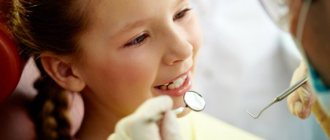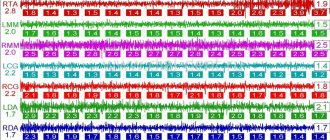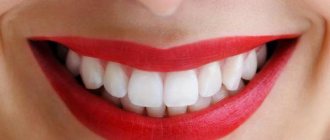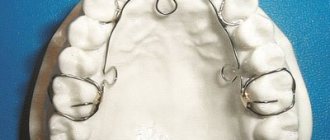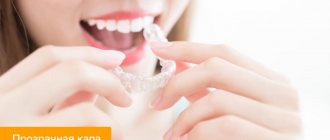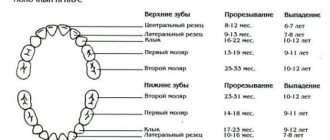Braces in the mouth cause certain inconveniences - not only physiological, but also psychological. It will take time to get used to them. In addition, a person's face may change after wearing braces. True, these changes are rather positive. What happens to the face during bite correction using braces?
In this article
- What consequences can there be from an incorrect bite?
- How to correct a malocclusion
- Mechanism of operation of orthodontic structures
- What happens to the face while wearing braces?
- How does the oval of the face change after braces?
- Do braces change your face forever?
- Oral care while wearing braces
Bite is the arrangement of the teeth of the upper and lower jaw relative to each other in a state of natural full closure. There are four types of correct bite that can be easily determined by your dentist. The teeth may be closed evenly, and the upper or lower teeth may be slightly pushed forward, generally without abnormalities. But there are five types of malocclusions; braces are used to correct them.
With an incorrect bite, the upper or lower jaw may be too forward, or if the jaw is closed, the teeth may be arranged crosswise, like scissors. With an open bite, they do not close completely; a large gap remains between the cutting edges.
What consequences can there be from an incorrect bite?
An incorrect bite negatively affects a person’s health if it is not corrected in time. Abrasion of the tooth edges may occur, and diction may be impaired. Pieces of food get stuck in the spaces between improperly growing teeth, and this is a direct path to the development of caries.
In addition to physiological problems, changes in the oval of the face also occur due to malocclusion. Due to the displacement of the lower jaw, horizontal asymmetry, hollowing or sagging of the cheeks may occur. The line of the mouth also changes - the corners of the lips droop, they become thinner, and do not close completely. The face is changing, and only clinical intervention will save the situation.
Nose
In patients with a reduced distance between the nose and upper lip and teeth protruding forward, the tip of the nose often noticeably drops down, giving the face a dull appearance, and the lip, on the contrary, protrudes upward. This occurs due to excessive tension in the muscles of the upper lip, which drags the skin along with it. Rhinoplasty is not needed in this case. After treatment with braces, the nose will rise slightly upward, and its owner will probably begin to receive compliments regarding her changed appearance.
How to correct a malocclusion
In orthodontics, there are a number of methods that help correct this jaw pathology. The most common of these are braces. They effectively correct malocclusion and dental imperfections. But wearing them is associated with some issues that the patient needs to know about before starting the correction.
Firstly, you need to prepare yourself psychologically that you will now have to wear a non-removable appliance on your teeth for a long time (at least a year). With it you will have to acquire new habits for caring for the oral cavity, in addition, braces change the shape of your face. Why is this happening? To do this, you need to understand how braces work.
Millions of people around the world have chosen braces as a means of correcting their bite. Many people complain about this aesthetic problem. But how effective is wearing braces? Are there any side effects?
According to the results of recent research in the field of orthodontics, wearing braces leads to serious changes in the oval of the face. This conclusion was reached by two well-known world-class experts - Eric Gibbs from the USA and Mike Mew from the UK. They have been sharing their opinions with patients and the public for over 10 years through publications in scientific journals and speaking engagements. But for most people, braces are still the #1 choice for correcting malocclusion. Next, we'll look at why trying to improve your appearance with braces can backfire.
Shocking facial changes
Experts in the field of orthodontics are reluctant to admit the indisputable fact that braces cause harm to those who use them, although they see the results of this method of bite correction right in front of them every day. When viewing their own photographs taken before and after orthodontic treatment, many patients are horrified and make complaints to the “specialists”. But the latter only shrug their shoulders or even refer the patient to a psychotherapist. The main problem is that patients are not warned about the possible consequences.
Braces can harm not only a person’s appearance, but also their health, including psychological health, since the results obtained often sharply reduce the patient’s self-esteem. This applies to the greatest extent to women who always want to look attractive. Practice shows that braces can change the facial features of even a naturally pretty girl. Natural beauty will not disappear, but the face loses some oval prettiness and looks more mature. It turns out that while wearing braces you can get a serious visual “increase” in age. According to the famous Russian doctor A.O. Savinova, the changed face will look like an “old woman’s face.”
Collecting data on the negative consequences of wearing braces on the shape of the face is the life's work of the American scientist Dr. Gibbs. The research results confirm what is already clear to many - orthodontic braces lengthen the face in the vertical direction. It is also known that the degree of influence on the shape of the face that braces have is related to the direction of facial growth. After wearing braces, people with so-called horizontally developed faces look best.
The main differences between “before” and “after”
The presented photos demonstrate the differences in the location of the upper jaw in the two girls, and how much this affects their appearance. In the first girl, the upper jaw is extended forward, and in the second, it is pulled down. The different structure of the upper jaw is not due to genetic factors, but to environmental influences. The latter, according to Dr. Mew, include the consequences of birth trauma, lack of breastfeeding, eating small amounts of solid food, pacifier or thumb sucking, and orthodontic intervention. The girl on the left is luckier, as her facial structure indicates that she grew up in more favorable conditions for the development of her face. The second girl's face looks elongated due to wearing braces. An increasing number of people are exposing themselves to such unfavorable changes.
The upper jaw, located horizontally and slightly protruded forward, is a distinctive characteristic of the faces of all cartoon characters who are positioned as handsome or beauties. The lines of their cheekbones are usually parallel to the line of the nose. If animators depict a villain, the maxillae of his face are slightly pushed back and pulled down. Similar techniques can be seen in the photo above.
The correct development of teeth is directly related to the direction of growth of the upper jaw. If it is horizontal, then the teeth do not grow as “crowded” as in the case of an elongated face and a vertically positioned upper jaw. These features were noticed and described first by Dr. Zakrisson (Norway) and subsequently by Dr. Woodside. They also noted that people with a vertically elongated face exhibit abnormalities in the development of the mandibular canines.
The development of intraoral devices that promote horizontal facial growth was started by European and American scientists in the last century. In the 80s and 90s, the world saw new devices - ALF and Bioblock, which are used to expand the upper jaw. The results of the studies are completely inconsistent with what orthodontists and dentists are taught. Despite the obvious advantages of the method used in the above-mentioned devices, it still does not receive due attention from official science and is used only in limited circles.
An illustrative example is the story of two twins, whose faces were initially absolutely identical. To treat malocclusion and crowding of teeth, they underwent two different courses of therapy. The first had his crowded teeth removed and then braces installed. The second was treated using the orthotropics method using an intraoral apparatus. A noteworthy fact is that his extra teeth were not removed. The photo shows that the first twin's upper jaw is pushed back and pulled down. This is the result of traditional orthodontic intervention. The second twin's jaw is slightly pushed forward, giving him more attractive facial features.
Reasons for lengthening the face as a result of wearing braces
When looking at photos of popular actresses and models in profile, it will become obvious that their faces have a characteristic feature - an extended upper jaw in the horizontal direction. Wearing braces leads to the opposite result - vertical stretching of the maxillae. This occurs due to many factors, but the main reason is the uniform impact of braces on all teeth of the jaws. The strongest teeth are those with powerful roots, so they take on the greatest force. As a result, there is a narrowing of the dental arches and a horizontal “pulling” of bone tissue. Installing braces does straighten teeth, but does not help achieve the desired result – a beautiful smile. They elongate the midface and make it appear flatter, which is completely inconsistent with the “model-like” look.
Changing the appearance of your face is not the only side effect of wearing straightening braces. As a result of the inward displacement of the upper jaw, the space for the tongue decreases, and snoring occurs during sleep. The best option for getting rid of snoring is to widen the upper jaw and move it forward. It follows that the traditional method of using braces to treat crowded teeth is the cause of unaesthetic elongation of the face and night snoring. A truly effective method is to widen the dental arches.
The girl in the photo did not have her upper canines erupting because there was no room for them in the dentition. Initial treatment involved surgery. But later she decided to turn to orthotropists. After a short course of therapy using the Bioblock device, sufficient space was created for normal canine growth. The girl’s father is a dentist by profession, but even he did not know about orthotropic methods, thanks to which her daughter’s face began to look more expressive and attractive.
Which method is better?
The goal of orthodontic treatment is only to straighten the teeth. But the side effects of such a procedure should force everyone to abandon it. Patients care not only about beautiful teeth, but also attractive facial features in general. Unfortunately, many who choose to wear braces are not even aware of the consequences that await them.
The main distinguishing feature of the orthotropic technique is the alignment of teeth by expanding the dental arches, rather than narrowing them. They use the Bioblock device, which has proven effective in a number of cases. The device straightens crooked teeth and helps to extend the upper jaw horizontally, making facial features more attractive. This method is advisable to use for treating children aged 8 to 12 years.
Correction of the upper jaw in adults is possible using the ALF device. This direction of medicine is called craniodontics (in our country – orthocraniodontics). The device is successfully used even for those patients who wore braces and are not satisfied with the results obtained. Unfortunately, this area of medicine has not yet received due attention in our country, but over time the situation will change, and everyone will have a chance to correct the horrific results of orthodontics.
The article uses photos from the sites claimingpower.com, forum.stom.ru, breket.info
Mechanism of operation of orthodontic structures
Each bracket is fixed to the crown and rotated in the desired plane to rotate and correct the position of the tooth in the row. Braces are made according to an impression of the patient’s jaw, taking into account all individual characteristics. Metal arches put pressure on the crowns, the periodontal ligaments are stretched, and the tooth gradually moves to the desired position. As it moves, the bone tissue is absorbed, and a new one is formed in the previous area.
In addition, other facial structures also change, since they are all connected together. This is why wearing braces inevitably changes the shape of your face.
Photos of installing braces before and after
If there is not enough space for the teeth, their crowded position is formed; the upper canines erupt later than all of them, when the space is already occupied by the rest of the teeth. As a rule, such teeth erupt outside and above the dentition, less often on the palatal side, and also do not erupt and remain in the bone. The average period for the eruption of fangs is up to 13 years, but it is better to focus on the sequence of teething; if all the permanent teeth have erupted, but the fangs have not, then this is a reason to consult an orthodontist.
Doctor: Tkalich Evgenia Aleksandrovna
What happens to the face while wearing braces?
The extent to which braces can change the shape of the face depends on the degree of tooth deformation and the type of bite that needs to be corrected. The behavior of the patient himself is also important - how accurately he will comply with the orthodontist’s instructions.
When wearing braces, interrelated changes occur in the maxillofacial structures. As they say in this case, braces break the face. The gradual displacement of bone tissue affects the muscles - their tone increases or, conversely, decreases. Let's take a closer look at how individual facial structures change.
Will the original appearance return after removal?
- If the installation of the system was carried out by a professional, and the patient followed all the rules, then the facial changes, as a rule, are minor and only benefit the person.
- If the correction was unsuccessful and led to severe deformation, you will have to try to restore the face. To speed up this process, you can use facial massage and face building (exercises aimed at the facial muscles). You can do gymnastics yourself, but massage is better to trust to an experienced cosmetologist.
How does the oval of the face change after braces?
A common question before installing orthodontic structures is whether braces break the oval of the face? Yes, after wearing them, some changes in the shape of the cheekbones and cheeks are possible in some cases. How obvious the changes will be depends on the type and degree of pathology.
Cheeks
The way the overall shape of the face looks, of course, is greatly influenced by the cheeks. Usually, after using braces, they become more sunken, and this is due to the following reasons. The doctor removes the extreme “eights”, which almost always interfere with the correction of the bite. The second factor that affects hollow cheeks while wearing braces is a change in diet. The patient's menu now includes much more liquid food and fewer snacks.
But gradually the place of the removed outer teeth is filled with bone tissue, and the diet becomes more complete as you get used to the braces, and the cheeks can acquire their previous roundness.
Cheekbones
Typically, after braces are installed, cheekbones become more noticeable. This occurs due to some hollowing of the cheeks and changes in facial expressions. If earlier, when smiling, a person tried to hide his teeth by tensing the muscles near his lips, now other muscle structures begin to work.
Nose
How does the nose change after braces? Many people note its slight upturning when wearing vestibular braces on the upper jaw, which persists even after their removal. This occurs due to a slight displacement and restructuring of the cartilage tissue of the nose. But women even like such changes in their faces - a cute upturned nose gives them a special charm.
Chin
Whether the position of the chin will change while wearing braces depends on the initial defect: if before their installation it was moved forward, now it can move back. If the bite defects are insignificant, then there will be no special metamorphosis with the chin.
Lips
Do the lips on the face change when wearing braces? This question especially worries girls. In this case, they even receive a pleasant bonus: now there are arches and braces under the lips, and they become a little plumper. Isn't this what all women dream about? However, after the braces are removed, the effect disappears.
What facial features may change
The result after treatment depends on which malocclusion was corrected.
Chin
The most noticeable changes are usually associated with the chin. With a distal bite, the chin is pushed back and looks too small. It is possible for the soft tissues of the face to sag even at a young age (“double chin”). When the bite is corrected and the teeth are closed correctly, the lower jaw is in the correct position.
With a mesial bite, the lower jaw, on the contrary, looks massive. The face has a gloomy expression. Typically, a double chin does not appear with such an overbite. After treatment, the lower part of the face remains clearly defined, but the chin becomes proportionate.
Correcting your bite improves your face shape
Do braces change your face forever?
Often, after removing braces, some experience disappointment when looking at their changed face in the mirror: it seems to them too narrow, and their cheekbones are noticeable. In fact, after braces, the face acquires its natural contours, becomes symmetrical and proportional: with a normal bite and teeth in their place. That is, a person sees in the mirror the appearance that he would have by nature if not for the existing pathology. Many see these changes as positive.
How does your face change after braces are removed? In general, it acquires its natural physiological form. Here are the changes a person may notice:
- the asymmetry of the oval of the face disappears;
- the lip line will become smoother;
- An overly heavy, protruding chin is reduced.
The question of how the face changes after braces can generally be answered in a positive way. With the restoration of the bite, the entire dental system begins to work correctly: the load on the muscles and ligaments is distributed evenly, which helps eliminate visual defects.
Correcting malocclusion is much easier in childhood and adolescence, when the bones of the face are not yet fully formed. But adjustments are also possible in adults, it just takes longer.
However, the problem should not be neglected and a visit to a specialist should not be delayed. The sooner orthodontic treatment is started, the faster its results will be achieved: you will get a symmetrical oval face and will be able to show off your beautiful smile without embarrassment.
There are no symmetrical faces
Despite the fact that it seems to us that by nature our faces are more or less symmetrical, in fact this is not the case, and there are still differences between the left and right sides, even if they are practically invisible.
Of course, there are not many sharply asymmetrical faces, but symmetry errors in the jaw area due to curvature of the teeth are common. The good news is that in this case the orthodontist works wonders! For a good doctor, the patient’s appearance is always a priority and he always takes into account the beauty of the profile and contours of the jaw when planning orthodontic treatment. Yes, there will be changes, definitely for the better: the face will acquire the missing symmetry, its features will become more harmonious.
Therefore, if you are indicated for treatment by an orthodontist, but you just can’t decide on it, it’s time to put aside unnecessary fears and feel free to make an appointment with the doctor!
Oral care while wearing braces
It should be remembered that during this period, particularly careful oral hygiene is required. Braces are a non-removable structure, and pieces of food get stuck under them, which need to be removed in a timely manner. Regularly carefully clean the oral cavity and the braces system itself with a special brush every time after eating. While wearing braces, it is advisable to floss to remove food debris between the teeth and rinse them using an irrigator. If you neglect your oral care during this period, your teeth may develop caries.
Brushing teeth and getting food stuck
Once you get braces, food starts getting stuck everywhere it can. And when elastic chains are attached to the arches, it gets even worse! Orthodontists rightly say that dental hygiene is extremely important when wearing braces! This is true. And “clean” teeth move better. In addition, on the Internet you can find photos of the consequences of poor hygiene. Looks disgusting.
The orthodontist says that it is necessary to brush your teeth after every meal and for at least 10 minutes. The thing about 10 minutes is sacred. That's how it worked for me. But brushing your teeth after every meal is basically unrealistic! In addition, brushing your teeth too often will also not bring anything good. I recommend brushing your teeth 2, or preferably 3 times a day, but no more than three times! Read more about cleaning teeth with braces: brushes and brushes.
At first, I even tried not to go to cafes and restaurants because food would get stuck in my teeth. Score it. Don't deprive yourself of the joys of life! Just always have a toothpick with you. And some water to rinse your mouth.
Chewing gum. They wrote on the forums that it gets stuck in the teeth. Maybe it’s not critical, but I didn’t try it while I was wearing braces. And now I’m out of the habit)
Consequences of frequent and long brushing of teeth
Simple calculations show that toothpaste stays in your mouth and on the skin of your lips and chin for about half an hour every day.
You will most likely experience dry mouth after brushing your teeth. After getting braces, I always started carrying a small bottle of water with me. Drinking clean water is beneficial. But there is a caveat: it is not advisable to drink a lot of water in the evening, especially if you are prone to swelling. I often got out of the situation with a glass of cool, dry white wine in the evening, when I could no longer drink a lot of water. I don’t know how much of a solution this is, but it seems to have helped me. There is another remedy, non-alcoholic;)) - succinic acid in tablets - cheap and useful in all respects.



